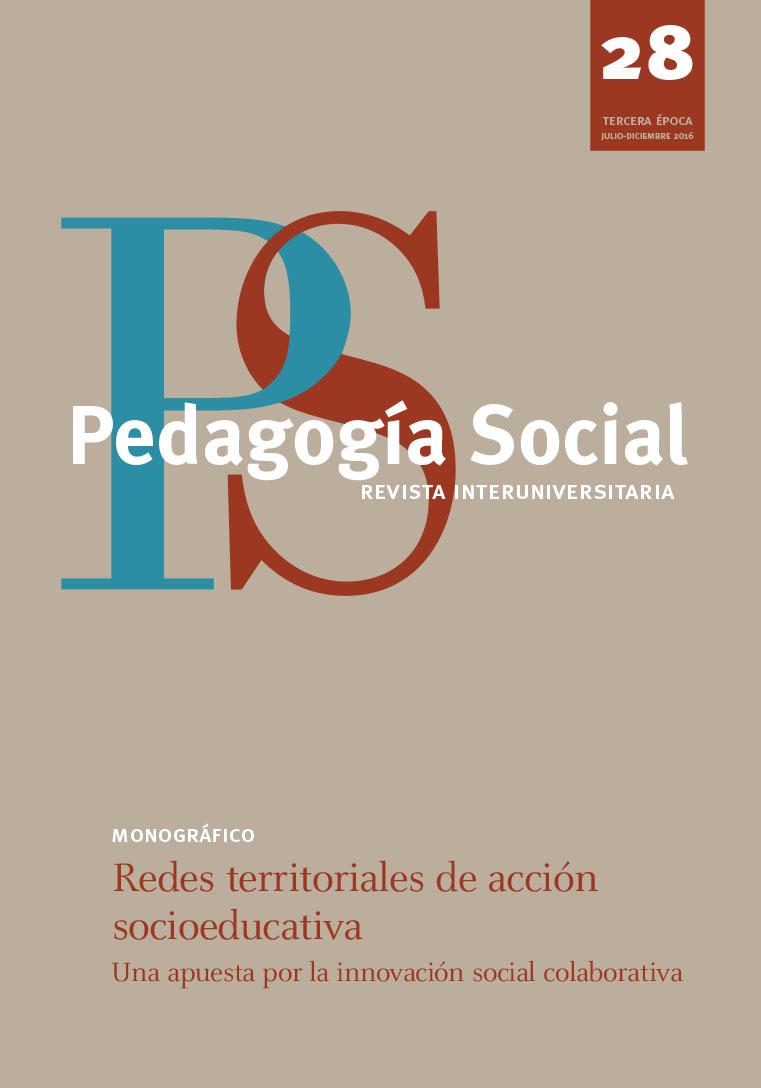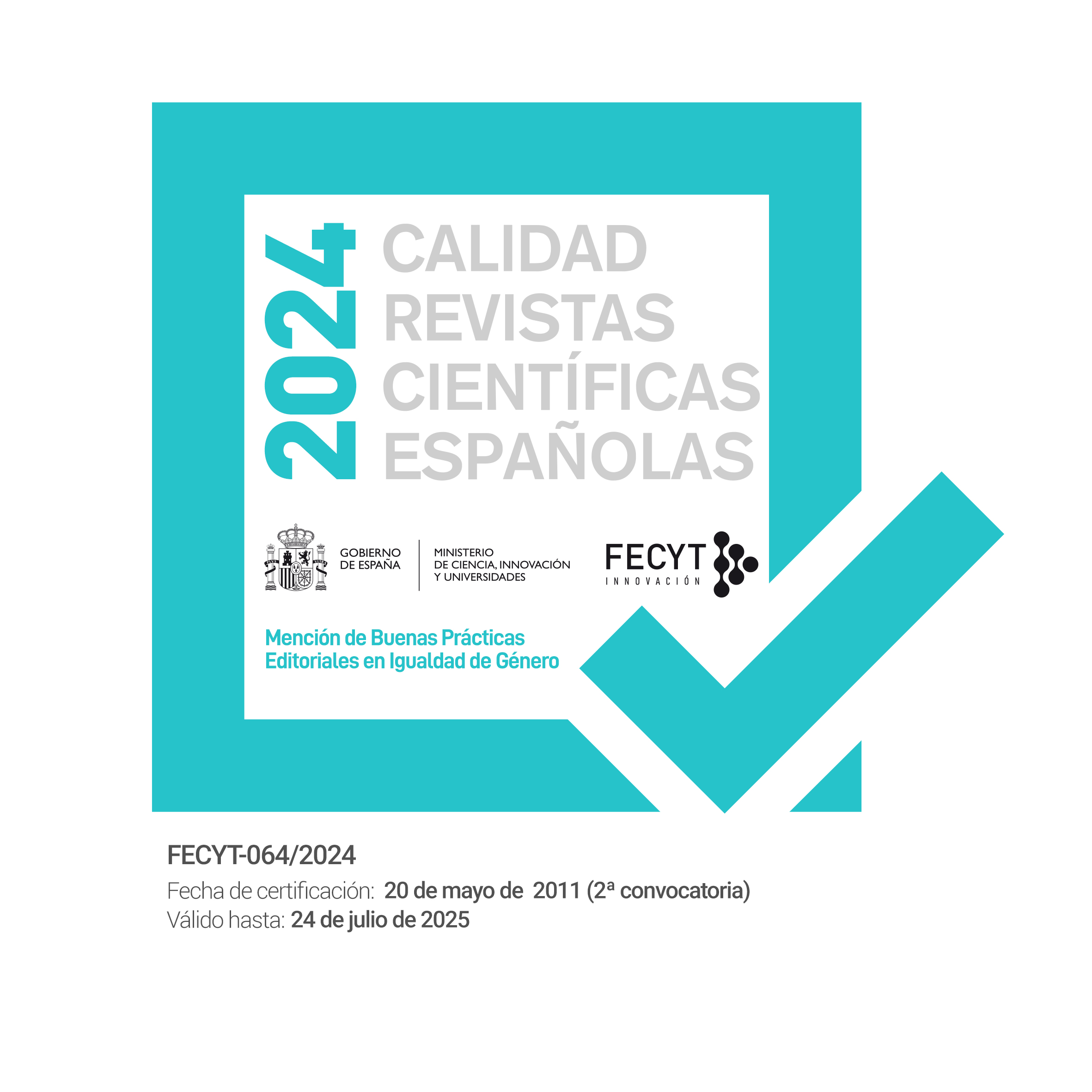Transformando la gobernanza para la mejora de la innovación educativa y social
DOI:
https://doi.org/10.7179/PSRI_2016.28.08Palabras clave:
gobernanza, innovación, políticas educativas, políticas sociales, liderazgo transformacionalResumen
En las últimas décadas ha habido una destacada proliferación de redes de gobernanza en diferentes ámbitos que han dado paso a numerosos estudios centrados en una gobernanza interactiva y relacional. Este artículo pretende contribuir al desarrollo de la investigación sobre gobernanza socioeducativa mediante el estudio de cómo la colaboración en redes de gobernanza puede estimular la innovación educativa y social. El rtículo presenta una descripción de las bases y principios de las redes de gobernanza, así como una visión general de las teorías que las fundamentan. En primer lugar, el artículo define el concepto de redes de gobernanza y a continuación describe las teorías que sustentan su proliferación. En segundo lugar, define el concepto de innovación y discute como la colaboración en redes puede estimular la innovación social y educativa. Finalmente, se discute sobre cómo puede iniciarse, facilitarse y mantenerse la innovación colaborativa a través de nuevas formas de liderazgo y gestión.
Descargas
Citas
Agranoff, R. (2003). Leveraging Networks: A Guide for Public Managers Working across Organisations. Arlington: IBM Endow-ment for The Business of Government.
Agranoff, R., & McGuire, M. (2003), Collaborative Public Management: New Strategies for Local Government, Washington, DC: Georgetown University Press.
Almirall, R., Díaz-Gibson, J., Dot, M., Moya, J., Ramírez, L., & Ubieto, R. (2012). Informe d’Avaluació dels costos i beneficis del mod-el Interxarxes. Estudi valoratiu de l’experiència del programa Interxarxes (2000-2012). Institut Municipal de Serveis Socials i Districte d’Horta-Guinardó: Barcelona.
Ansell, C., & Gash, A. (2007), Collaborative governance in theory and practice, Journal of Public Administration Research and Theory, 18(4), 543-571.
Ansell, C., & Gash, A. (2012), Stewards, Mediators, and Catalysts: Towards a Model of Collaborative Leadership, The Innovation Journal, 17(1), 1-21.
Ansell, C., & Torfing, J. (Eds) (2014), Public Innovation and Collaboration through Design, Abingdon: Routledge.
Argyris, C., & Schön, D. (1978), Organizational Learning: A Theory of Action Perspective, Reading, MA: Addison-Wesley Publishing Company.
Bason, C. (2010), Leading Public Sector Innovation, Bristol: Policy Press.
Benz, A., & Papadopoulos, Y. (2006). Governance and Democracy. London: Routledge.
Bogers, M., Affuh, A., & Bastian, B. (2010). Users as Innovators: A Review, Critique, and Future Research Directions. Journal of management, 36(4), 857-875.
Bommert, B. (2010), Collaborative innovation in the public sector, International Public Management Review, 11(1), 15-33.
Csikszentmihalyi, M. (1996), Creativity: Flow and the Psychology of Discovery and Invention, New York, NY: Harper Collins.
Considine, M., Lewis, J., & Alexander, D. (2009), Networks, Innovation and Public Policy, Basingstoke: Palgrave-Macmillan.
Crosby, B., & Bryson, J. (2010), Integrative leadership and the creation and maintenance of cross-sector collaboration, Leadership Quarterly, 21(2), 211-230.
Crozier, M., Huntington, S., & Watanuki, J. (1975). The Crisis of Democracy. New York: The New York University Press. Dean, M. (1999). Governmentality: Power and Rule in Modern Society. London: Sage.
Díaz-Gibson, J., Civís, M., & Guardia (2013) Strengthening education through collaborative networks: leading the cultural change. School Leadership and Management, 34(2), 179-200.
Díaz-Gibson, J., Civís, M., & Longás, J. (2013). La Gobernanza de Redes Socioeducativas: claves para una gestión exitosa. Teoria de la Educación. 25(2), 213-230.
Djelic, M., & Sahlin-Andersson, K. (eds.) (2006). Transnational Governance: Institutional Dynamics of Regulation. Cambridge: Cam-bridge University Press.
Doig, J., & Hargrove, E. (1987), Leadership in Innovation: Entrepreneurs in Government, Baltimore, Maryland: The John Hopkins University Press.
Eggers, B., & Singh, S. (2009), The Public Innovators Playbook, Washington, DC: Harvard Kennedy School of Government.
Engeström, Y. (2008), From Teams to Knots: Activity-Theoretical Studies of Collaboration and Learning at Work, New York, NY:Cambridge University Press.
Emerson, K., & Nabatchi, T. (2015), Collaborative Governance Regimes, Washington, DC: Georgetown University Press. European Commission (2013), European Public Sector Innovation Scoreboard, Brussels: EU.
Foucault, M. (1991). Governmentality. Pp. 87-104. In The Foucault Effect, ed. G. Burchell, C. Gordon & P. Miller. Hertfordshire: Har-vester Wheatsheaf.
Gray, B. (1989), Collaborating: Finding Common Ground for Multiparty Problems, San Francisco: Jossey-Bass.
Hartley, J. (2005), ‘Innovation in governance and public service: Past and present’, Public Money & Management, 25(1), 27-34.
Hartley, J., Sørensen, E., & Torfing, J. (2013), ‘Collaborative innovation: A viable alternative to market-competition and organizational entrepreneurship?’, Public Administration Review, 73(6), 821-830.
Heclo, H. (1978). Issue networks and the executive establishment. Pp. 87–124 in The New American Political System, ed. A. King. Washington, DC: American Enterprise Institute.
Heifetz, R., Linsky, M., &Grashow, A. (2009), The practice of adaptive leadership: Tools and tactics for changing your organiza-tion and the world, Cambridge, MA: Harvard Business Press.
Hirst, P. (2000). Governance and democracy. Pp. 13-35 In Debating Governance, ed. J. Pierre. Oxford: Oxford University Press. Hood, C. (1986). The Tools of Government. Chatham: Chatham House.
Jessop, B. (1998). The Rise of Governance and the Risks of Failure: the Case of Economic Development. International Social Sci-ence Journal, 50(155), 29-45.
Jessop, B. (2002). The Future of the Capitalist State. Cambridge: Polity Press.
Keast, R., Brown, K., & Mandell, M. (2007), Getting the right mix: Unpacking integration, meanings and strategies, International Public Management Journal, 10(1), 9–34.
Kickert, W., Klijn, E., & Koppenjan, J. (eds.) (1997). Managing Complex Networks. London: Sage.
Klijn, E., &Skelcher, C. (2007). Democracy and governance networks: Compatible or not? Public Administration, 85(3): 587-608.
Kohler-Koch, B., & Eising, R. (eds.) (1999). The Transformation of Governance in the European Union. London: Routledge. Kooiman, J. (ed.) (1993). Modern Governance. London: Sage.
Kooiman, J. (2003). Governing as Governance. London: Sage.
March, J., & Olsen, J. (1995). Democratic Governance. New York: The Free Press.
Marsh, D., & Rhodes, R. (eds.) (1992). Policy Networks in British Government. Oxford: Oxford University Press.
Mayntz, R. (1993a). Modernization and the logic of interorganizational networks. Pp. 3-18 in Societal Change between Markets and Organization, ed. J. Child, M. Crozier & R. Mayntz. Aldershot: Avebury.
Mayntz, R. (1993b). Governing failure and the problem of governability: Some comments on a theoretical paradigm. Pp. 9-20 in Modern Governance, ed. J. Kooiman. London: Sage.
Mezirow, J. (2000), Learning as Transformation: Critical Perspectives on a Theory in Progress, San Francisco, CA: Jossey Bass.
Milward, H., & Provan, K. (2006). A Manager’s guide to choosing and using networks. Arlington: IBM Endowment for The Business of Government.
Morse, R. (2010), Integrative public leadership: Catalyzing collaboration to create public value, The Leadership Quarterly, 21(2), 231–245.
Meuleman, L. (2008), Public Management and the Metagovernance of Hierarchies, Networks and Markets, Heidelberg: Springer Press.
Nambisan, S. (2008), Transforming government through collaborative innovation, Public Manager 37(3): 36-41.
O’Leary, R., & Bingham, L. B. (eds) (2009), The Collaborative Public Manager, Washington, DC: Georgetwon University Press.
Olsen, J. (2009). EU governance: Where do we go from here? Pp. 191-209 in European Multi-level Governance, ed. B. KohlerKoch & F. Larat. Cheltenham: Edward Elgar.
Page, S. (2010), Integrative leadership for collaborative governance: Civic engagement in Seattle, The Leadership Quarterly, 21(2), 246-263.
Parry, K., & Bryman, A. (2006), Leadership in organizations. In S. Clegg, C. Hardy, T. Lawrence and W. Nord (Eds), The Sage Hand-book of Organization Studies, London, UK: Sage Publications, pp. 447-468.
Peters, B. (2010), Metagovernance and public management, in Osborne, S. P. (Ed.), The New Public Governance?, London: Rout-ledge, 36-51.
Peters, B. (2011). Institutional Theory in Political Science. London: Continuum.
Polsby, N. (1984), Political Innovation in America: The Politics of Policy Initiation, New Haven, CT: Yale University Press.
Powell, W., & DiMaggio, J. (1983). The iron cage revisited: Institutional isomorphism and collective rationality in organisational fields. American Sociological Review, 48(2).147-60.
Powell, W., & DiMaggio, J. (1991). The New Institutionalism in Organizational Analysis. Chicago: University of Chicago Press.
Provan, K., & Kenis, P. (2008). Modes of network governance: Structure, management, and effectiveness. Journal of Public Administration Research and Theory, 18(2). 229-52.
Provan, K., & Milward, B. (1995), A preliminary theory of interorganizational effectiveness: A comparative study of four commu-nity mental health systems, Administrative Science Quarterly, 40(1), 1-33.
Renée, M., & McAlister, S. (2011). The Strengths and Challenges of Community Organizing as an Education Reform Strat-egy: What the Research Says. Annenberg Institute for School Reform at Brown University.
Rhodes, R. (1997). Understanding Governance. Buckingham: Open University Press.
Roberts, N., & Bradley, R. (1991), Stakeholder collaboration and innovation, Journal of Applied Behavioural Science, 27(2), pp. 209–227.
Roberts, N., & King, P. (1996), Transforming Public Policy: Dynamics of Policy Entrepreneurship, San Francisco, CA: Jossey-Bass.
Rose, N., & Miller, P. (1992). Political power beyond the state: problematics of government. British Journal of Sociology, 43(2), 172-205.
Sabatier, P. (1988), An advocacy coalition framework of policy change and the role of policy oriented learning therein, Pol-icy Sciences, 21(2), 129-168.
Scharpf, F. (1994). Games real actors could play: Positive and negative coordination in embedded negotiations. Journal of Theoretical Politics, 6(1), 27-53.
Scharpf, F. (1999). Governing in Europe: Effective and Democratic? Oxford: Oxford University Press.
Shirley, D. (2009). Community Organizing and Educational Change: A Reconnaissance, Journal of Educational Change, 10, 229–237.
Skelcher, C., & Torfing, J. (2010), Improving democratic governance through institutional design: Civic participation and dem-ocratic ownership in Europe, Regulation and Governance, 4(1), 71-91.
Straus, D. (2002), How to Make Collaboration Work, San Francisco, CA, Berrett Koehler Publishers.
Sørensen, E., & Torfing, J. (2005a). Network governance and post-liberal democracy, Administrative Theory and Praxis, 27(2), 197-237.
Sørensen, E., & Torfing, J. (2005b). The democratic anchorage of governance networks. Scandinavian Political Studies, 28(3), 195-218.
Sørensen, E., & Torfing, J. (eds.) (2007). Theories of Democratic Network Governance. Basingstoke: Palgrave Macmillan. Sørensen, E., & Torfing, J. (2009). Making governance networks effective and democratic through metagovernance. Public Administration, 87(2), 234-58.
Sørensen, E., & Torfing, J. (2011), Enhancing collaborative innovation in the public sector, Administration and Society, 43(8), 842-868.
Torfing, J., Peters, B., Pierre, J., & Sørensen, E. 2012. Interactive Governance: Advancing the Paradigm. Oxford University Press.
Torfing, J., & Krogh, A. H. (2013), Samarbejdsdrevet innovation i bandeindsatsen, Copenhagen: DJOEF Publishers.
Voorberg, W., Bekkers, V., & Tummers, L. (2014), A systematic review of co-creation and co-production’, Public Management Review, 17(9), 1333-1357.
Von Hippel, E. (1988), The Sources of Innovation, Oxford: Oxford University Press.
Von Hippel, E. (2005), Democratizing Innovation, Cambridge, MA: The MIT Press.
Wart, M. (2013), Lessons from leadership theory and contemporary challenges of leaders, Public Administration Review, 73(4), 553–564.
Warren, M. (2009). Governance-driven democratization. Critical Policy Analysis, 3(1), 3-13.
Descargas
Publicado
Cómo citar
Número
Sección
Licencia
Derechos de autor 2016 Pedagogía Social. Revista Interuniversitaria

Esta obra está bajo una licencia internacional Creative Commons Atribución-NoComercial-CompartirIgual 4.0.
Derechos de reproducción y archivo
La versión publicada de los artículos podrá ser autoarchivada por sus autores en repositorios institucionales y temáticos de acceso abierto. No obstante la reutilización total o parcial de los mismos en nuevos trabajos o publicaciones deberá ser autorizada por Pedagogía Social. Revista Interuniversitaria.
Los trabajos publicados deberán ser citados incluyendo el título de la Revista, Pedagogía Social. Revista Interuniversitaria, nº, páginas y año de publicación.
Responsabilidades éticas
Pedagogía Social. Revista Interuniversitaria no acepta material publicado anteriormente en otros documentos. Los/as autores/as son responsables de obtener los permisos oportunos para reproducir parcialmente material de otras publicaciones y citar correctamente su procedencia. Estos permisos deben solicitarse tanto al autor/a como a la editorial que ha publicado dicho material.
Es obligación de Pedagogía Social. Revista Interuniversitaria detectar y denunciar prácticas fraudulentas.
En la lista de autores/as firmantes deben figurar únicamente aquellas personas que han contribuido intelectualmente al desarrollo del trabajo.
La revista espera que los/as autores/as declaren cualquier asociación comercial que pueda suponer un conflicto de intereses en conexión con el artículo remitido.
Los autores deben mencionar en el manuscrito, preferentemente en el apartado del método, que los procedimientos utilizados en los muestreos y controles han sido realizados tras la obtención de consentimiento informado.
La revista no utilizará ninguno de los trabajos recibidos con otro fin que no sea el de los objetivos descritos en estas normas.
Aviso de derechos de autor/a
© Pedagogía Social. Revista Interuniversitaria. Los originales publicados en las ediciones impresa y electrónica de esta Revista son propiedad del Pedagogía Social. Revista Interuniversitaria, siendo necesario citar la procedencia en cualquier reproducción parcial o total.
Salvo indicación contraria, todos los contenidos de la edición electrónica se distribuyen bajo una licencia de uso y distribución “Creative Commons Reconocimiento-No Comercial 3.0 España” (CC-by-nc). Puede consultar desde aquí la versión informativa y el texto legal de la licencia. Esta circunstancia ha de hacerse constar expresamente de esta forma cuando sea necesario.






